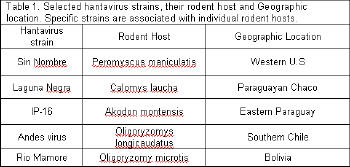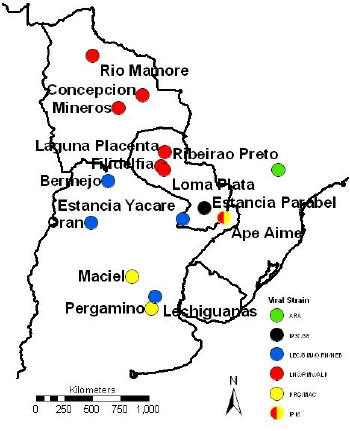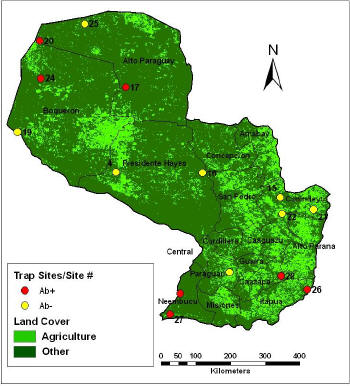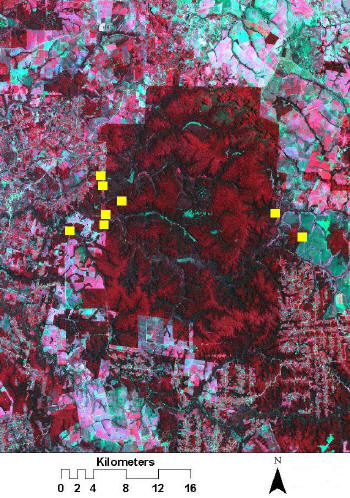Despite his great success in the Soviet Union, Pavlovsky's work was largely unknown outside of his home country. Recently, however, there has been a revival of interest in landscape epidemiology among researchers studying infectious disease (Ostfield et al., 2005). Much of this renewed interest can be attributed to the widespread availability of spatial landscape data, along with the Geographical Information Science (GIScience or GISc) tools with which to analyze them. GIScience, which includes GIS, remote sensing, automated cartography and spatial analysis (spatial mathematics, statistics and modeling) provides an integrated, synergistic environment in which spatial data relevant to understanding disease dynamics can be acquired, visualized, analyzed and communicated to a user community. In this article, we will discuss the use of GISc for understanding the role of landscape and landscape change in the occurrence and transmission of hantavirus.
Hantaviruses are single-stranded RNA viruses hosted by rodents of the Sigmadontinae subfamily. There are numerous subspecies or strains of hantavirus, each associated with a particular rodent host species (Table 1). In the western hemisphere, the virus is associated with Hantavirus Pulmonary Syndrome (HPS), an acute cardiopulmonary disease fatal in about 30 to 50% of all cases. It is believed that humans contract HPS through inhalation of aerosolized rodent waste, which contains live virus shed by the host. Fortunately, there are few HPS cases each year, but often the cases come in clusters or outbreaks. Managing the impacts of these outbreaks can be a significant public health problem, particularly in less-developed countries with inadequate medical infrastructure. Better understanding of the ecology of hantavirus and the rodents that carry it could lead to improved prediction of locations and times when the risk of hantavirus disease occurrence will be high, allowing public health authorities to focus surveillance efforts and concentrate resources where the need is greatest.
Between 1993 and 2004, nearly 2,000 cases of HPS were reported in the Americas. Of these, nearly three-quarters occurred in Central or South America. In Paraguay, there have been over a hundred cases, the first of which were identified in 1995.
 |
Although the total number of cases of HPS in Paraguay is lower than in other South American countries, the situation there warrants attention for three reasons. First, the relatively small number of cases is misleading. Because of the low population in Paraguay, the relative rates of HPS occurrence are actually among the largest in Latin America. Also, because of its less developed medical infrastructure, it is likely that a much larger number of cases have gone unreported in Paraguay. Second, the ecology of hantavirus in Paraguay is particularly complex, with as many as four viral strains co-circulating within the same geographical area (Chu et al., 2003). Finally, empirical evidence from a number of diverse locations has shown a consistent relationship between human land cover change and the presence of hantavirus. Paraguay is currently undergoing very rapid land cover change, especially in the Atlantic Forest of eastern Paraguay. The convergence of these three factors make parts of Paraguay a natural laboratory for understanding the complicated pathogen-host-environment system associated with hantavirus.
Addressing this complex research problem has engaged all of the tools of GISc. Remote sensing has provided much of the input data stream; spatial statistics and modeling have been used to develop and test hypotheses; cartographic techniques are being used to visualize the input data and modeling results; and GIS provides the tools and the organizing framework in which to conduct these analyses. Combining these into an integrated GISc framework has proven to be challenging, but the combination of geographical analysis techniques has proven very useful. Using the GISc framework, it is possible to ask fundamental questions about the landscape epidemiology of hantavirus in Paraguay. Questions about the spatial scale of disease occurrence have been particularly interesting.
When analyzing the effect of spatial scale, geographers often make use of hierarchy theory (Phinn et al., 2004), which focuses on the interaction between processes occurring over several organizational levels arranged according to their spatial extent. Under hierarchy theory, coarser scale processes constrain finer scale processes, which can then provide feedback back up-scale. For example, at coarse spatial scales, climate could be a major constraint on hantavirus occurrence (Engelthaler et al., 1999) but at finer scales, land cover change might become important (Yahnke et al., 2001). At still finer scales, rodent population dynamics must be considered (Suzan et al., 2006). Before hypotheses about scale can be tested, it is first necessary to define the scales of interest and organize the data accordingly. The scales investigated as part of our research in Paraguay range from tens of square meters to thousands of square kilometers. Each scale yields a unique piece of the hantavirus ecology puzzle. By looking at the various scales we can get improved understanding of the landscape-host-virus system, including what environmental factors might cause virus levels in the host rodent community to increase to the level where they impact human populations.
At the largest spatial scale (thousands of square kilometers), we are analyzing interspecific genetics of the virus. While this part of the study is primarily conducted using the techniques of molecular genetics, the findings have been supported with geographical analysis. By mapping the occurrence of various hantavirus strains, it is possible to visualize the evolution of the virus spatially. Strains of the virus that are genetically more similar to each other are also geographically closer. In particular, there is a potential genetic reassortment that has occurred in Paraguay, where a viral strain whose genome shows elements of two other strains has been discovered. The 'new' strain, shown as a two-colored symbol in Figure 1, shares genetic sequences with both the Pergamino and Laguna Negra strains of hantavirus, and its geographical location roughly "between" known locations of these two viral strains supports the idea that reassortment has occurred.
At finer spatial scale, (hundreds of square kilometers), we were able to resolve some of the effects of human disturbance on the prevalence of hantavirus in Paraguay (Goodin et al., 2006). One of the questions we could answer at this scale was whether the prevalence of hantavirus among the host rodents was really higher in human disturbed habitats. Using a one km resolution habitat map created from coarse resolution SPOT-VGT data and a rodent trapping data set that covered a wide variety of locations in Paraguay, we found that agricultural land was associated with hantavirus. At this spatial scale, we could not discern why land cover change was important, but the key finding here is that landscape change was associated with an increase in the prevalence of hantavirus. This scale was large enough to include several species of rodents and strains of hantavirus, offering some insight into hantavirus ecology.
 |
At even finer spatial scales (tens of square kilometers) we can begin to address how land cover disturbance results in greater occurrence of hantavirus. At the Reserva Natural de Bosque Mbaracayu (RNBM), a biosphere reserve site located in northeastern Paraguay, we have established a number of research sites, each representing a specific habitat type. Using these sites, we can focus on individual host species and hantavirus strains, observing how these are affected by habitat type and landscape change. While this research is ongoing, studies at this localized scale are helping to discover which types of landscape change are more important to the increase of hantavirus prevalence.
At even finer scales, (tens of square meters), we can observe spatial patterns of the host-virus systems within each of the trapping sites shown in Figure 3. At this scale we can look at interactions between individual rodents and try to understand better what factors increase the transmission rates of hantavirus. These interactions should shed even more light on how more localized interactions can affect the prevalence of hantavirus in a specific location or landscape.
Many of the techniques we have used in this research might also be useful for analyzing the landscape epidemiology of other infectious diseases. GISc is currently being used to better understand a variety of diseases and disease vectors [Ostfeld, 2005]. The research we have described here is a complex, multidisciplinary undertaking requiring the skills and expertise of a variety of scientific disciplines. Geographical information science is the "glue" that combines the various disciplinary perspectives needed to truly understand a complex phenomenon like disease. As the pace of global change accelerates, it is quite probable that even more diseases will emerge or re-emerge. Understanding the environmental factors which help propagate these diseases and protecting human populations from them will remain a task for which the skills of the GIScientist will be needed.
References
Chu, YK, B Milligan, RD Owen, DG Goodin, and CB Jonsson. 2006. Phylogenetic and Geographical Relationships of Hantavirus Strains in Eastern and Western Paraguay. American Journal of Tropical Medicine and Hygiene. In Press.
Ostfeld RS, GE Glass, and F Keesing. 2005. Spatial Epidemiology: an emerging (or re-emerging) discipline. Trends in Ecology and Evolution. 20:328-336
Goodin DG, DE Koch, RD Owen, YK Chu, JMS Hutchinson, CB Jonsson. 2006. Land cover associated with hantavirus presence in Paraguay. Global Ecology and Biogeography. 15:519-527.
Pavlovsky, EN 1966. Natural Nidality of Transmissible Diseases: With Special Reference to the Landscape Epidemiology of Zooanthroponoses. University of Illinois Press. Urbana, Ill.
Phinn, SR, DA Stow, J Franklin, LAK Mertes, J Michaelson. 2004. Remotely Sensed Data for Ecosystem Analyses: Combining Hierarchy Theory and Scene Models. Environmental Management. 31:429-441.
Suzan, G. 2006. The responses of hantavirus host communities to habitat fragmentation and biodiversity loss in Panama. UMI Proquest publishing.
Yankhe, CJ, PL Meserve, TG Ksiazek, JN Mills. 2001. Patterns of infection with Laguna Negra virus in wild populations of Calomys laucha in the central Paraguayan Chaco. American Journal of Tropical Medicine and Hygiene 26: 768-776.

